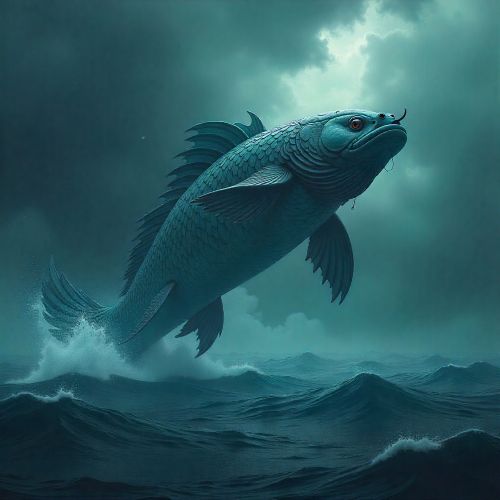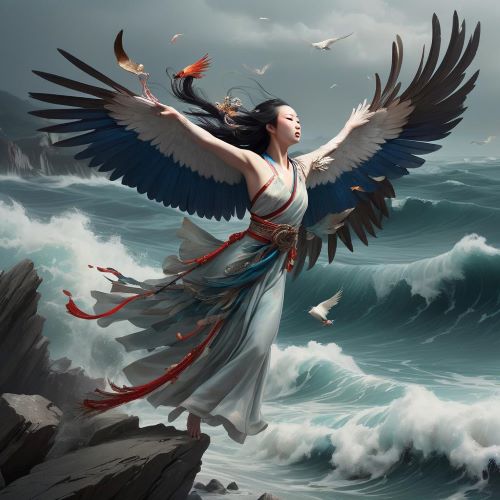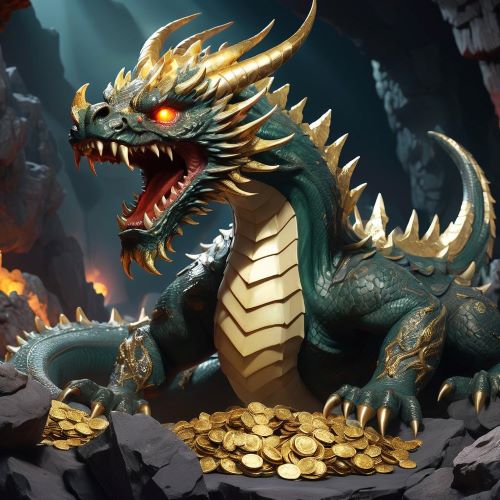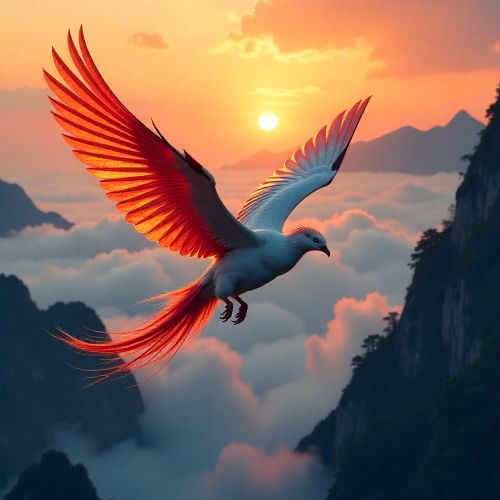Peng : The Chinese Giant Bird of Transformation
Listen
At a glance
| Description | |
|---|---|
| Origin | Chinese Mythology |
| Classification | Animals |
| Family Members | N/A |
| Region | China |
| Associated With | Strength, Size, Transformation |
Peng
Introduction
In the rich world of Chinese mythology, few beings capture the imagination like the Peng (鹏). This colossal bird first appears in the Daoist classic Zhuangzi, where it symbolizes transformation, spiritual awakening, and the vast potential of existence itself. According to the legend, the Peng emerges from a massive fish known as Kun (鲲), which dwells in the dark northern seas. One day, Kun transforms into the Peng, rising from the depths to soar across the heavens. This dramatic metamorphosis reflects a key Daoist idea — that life itself is fluid, ever-changing, and capable of transcendence beyond the material world. For centuries, the tale of Peng has remained one of China’s most profound mythological metaphors, representing freedom from limitations and the pursuit of the infinite.
Physical Traits
The Peng is described as a bird of unimaginable size and power. Its wings are said to stretch so wide that they cover the sky like rolling clouds, and when it takes flight, its movement stirs great winds and waves across the seas below. Ancient texts describe its journey spanning ninety thousand li — a poetic way of expressing distances so vast they defy comprehension. The Peng’s ascent from sea to sky symbolizes more than just might; it represents transformation on a cosmic scale. The creature’s earlier existence as the Kun, an enormous fish dwelling in the northern depths, completes the cycle of duality — from the waters of potential to the air of liberation. In this, the Peng embodies the Daoist balance between yin and yang, depth and height, stillness and motion.
Family
Unlike many divine beings in Chinese mythology, the Peng has no parents or offspring. It is a creature of transformation rather than lineage. Its story is born from metamorphosis, not ancestry — a reflection of Daoist thought where true existence transcends form and family. However, as Chinese religion evolved and absorbed Buddhist influence, new interpretations arose. The Peng became associated with Dapeng Jinchi Mingwang, the Golden-Winged King of Illumination, a fierce guardian deity who protects sacred law and cosmic order. This connection shows how myths evolve across spiritual traditions, weaving Daoist philosophy with Buddhist cosmology. In this blended identity, the Peng is not just a creature of flight but a celestial protector — a divine symbol of justice, power, and spiritual authority.
Other names
The Peng is known by several names that reflect its mythic evolution. In Daoist texts, it is simply called Dapeng (大鹏), meaning “Great Peng.” In combination with its aquatic form, it becomes Kunpeng (鲲鹏), representing the dual nature of transformation. In Buddhist traditions, it is known as Dapeng Jinchi Mingwang (大鹏金翅明王), or “Golden-Winged King of Illumination,” emphasizing its divine and protective qualities. Each name captures a different facet of its being — the philosopher’s symbol of transcendence, the storyteller’s creature of awe, and the devotee’s guardian of light.
Powers and Abilities
The Peng’s most remarkable power lies in its transformation and its boundless flight. Rising from the ocean depths, it ascends to the highest heavens in a single, continuous motion — a journey that signifies enlightenment and liberation from the mundane world. Its wings command the winds and reshape the weather, creating storms with a single beat. The Peng’s mastery over both sea and sky makes it a symbol of balance between opposing realms. In Daoist philosophy, this reflects the idea of inner cultivation — the ability to transform one’s limited self (the Kun) into an expansive being of awareness (the Peng). In Buddhist contexts, the Dapeng form is often depicted as a fierce deity, capable of vanquishing evil spirits and maintaining cosmic harmony. Across traditions, the Peng embodies both power and peace, destruction and creation, always transcending boundaries.
Modern Day Influence
Today, the Peng continues to soar through modern Chinese culture as a timeless emblem of ambition and potential. The phrase “Kunpeng spreads its wings” is often used to describe individuals or enterprises destined for greatness. In literature and art, the Peng remains a powerful metaphor for breaking through limits — from classical poetry to contemporary novels, where it represents courage, self-transformation, and vast imagination. The legendary Song dynasty general Yue Fei was even described as a reincarnation of Dapeng, linking national heroism to the mythic bird’s grandeur. In modern branding, digital media, and motivational speeches, Peng is a recurring motif symbolizing the unstoppable rise of spirit, innovation, and national pride. Beyond myth, it has become a philosophy — that all beings hold within them the power to transform, to ascend, and to soar.
Related Images
Source
Realm Whispers. (n.d.). Unveiling the mystery of the Peng: The mythical giant bird of Chinese mythology. Retrieved November 2025, from https://realmwhispers.com
Wikipedia contributors. (2019, June 14). Dapeng Jinchi Mingwang. Wikipedia. https://en.wikipedia.org/wiki/Dapeng_Jinchi_Mingwang
Wikipedia contributors. (2004, June 17). Peng (mythology). Wikipedia. https://en.wikipedia.org/wiki/Peng_(mythology)
Kangdukwon Federation. (n.d.). Who (or what) is a Great Peng? Retrieved November 2025, from https://kangdukwon.org/2025/09/from-kun-to-peng/
Wikipedia contributors. (2002, November 9). Chinese mythology. Wikipedia. https://en.wikipedia.org/wiki/Chinese_mythology
Villains Wiki. (2024, October 28). Golden winged Great Peng. Villains Wiki. https://villains.fandom.com/wiki/Golden_Winged_Great_Peng
National Center for Biotechnology Information. (2024, May 14). An ethnography of construction and characteristics of … https://pmc.ncbi.nlm.nih.gov
Zhuangzi. (4th century BCE). Zhuangzi (Burton Watson, Trans.). Columbia University Press. (Original work attributed to Zhuang Zhou)
Realm Whispers. (2023, November 25). Unveiling the Mystery of the Peng: The Mythical Giant Bird of Ancient Chinese Lore. https://realmwhispers.com/birds/unveiling-the-mystery-of-the-peng-the-mythical-giant-bird-of-ancient-chinese-lore/
Teiser, S. F. (1994). The Scripture on the Ten Kings and the Making of Purgatory in Medieval Chinese Buddhism. University of Hawaii Press.
Birrell, A. (1993). Chinese Mythology: An Introduction. Johns Hopkins University Press.
Lagerwey, J. (2010). China: A Religious State. University of Hong Kong Press.
Robinet, I. (1997). Taoism: Growth of a Religion (P. Brooks, Trans.). Stanford University Press.
Frequently Asked Questions
What is Peng in Chinese mythology?
Peng is a mythical giant bird that originated from the Daoist text Zhuangzi. It transforms from a giant fish called Kun and symbolizes transformation and spiritual freedom.
What does Peng represent in Daoist philosophy?
Peng represents transcendence, the ability to rise beyond limitations, and the boundless potential within all beings to achieve spiritual elevation.
What is the relationship between Kun and Peng?
Kun is the fish form, and Peng is its transformed bird form. This metamorphosis symbolizes the journey from the depths of ignorance to the heights of enlightenment.
Is Peng connected to Buddhism?
Yes, in later interpretations, Peng was associated with Dapeng Jinchi Mingwang, a Buddhist guardian deity known as the Golden-Winged King, symbolizing divine protection and moral strength.
Why is Peng still relevant today?
Peng remains a cultural and motivational symbol in modern China, representing ambition, transformation, and limitless growth in both personal and national contexts.










